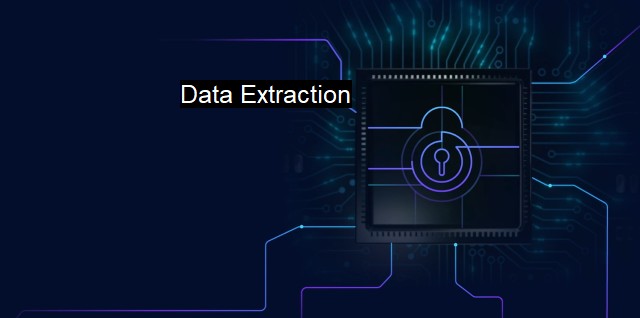What is Data Extraction?
Securing Networks: The Essential Role of Data Extraction in Cybersecurity and Antivirus Protection
Data extraction refers to the process through which relevant information is collected from data sources, including databases, text, images, or audio, for further data processing or data storage. In the cybersecurity and antivirus context, data extraction is synonymous with various security activities ranging from the identification of potential vulnerabilities to the extraction of malicious codes to the analysis of system risks.Professionals handle a massive amount of data daily. As cyberattacks heighten, security experts are forced to maneuver through an ever-growing list of logs, threat alerts, and security incident reports which carry critical and rich information. With such a volume of data, extracting the necessary details can prove challenging. That's where data extraction steps in—it helps unzip the hidden treasure beneath data, enabling security analysts to promptly identify and respond to security matters.
Cybersecurity data extraction works in several ways. One of them is in the area of security monitoring where it usually begins with the acquisition of system data via several types and tools. This involves reviewing event logs, systems states, configurations, and system call traces, amongst others. Expert systems then interpret the collected data searching for known vulnerabilities or intrusion patterns.
Another area is in intrusion detection systems (IDS). IDS are used to identify malicious activity within a network or system and can either be host-based or network-based. Both generate lots of data, especially in large organizations. Extracting relevant data from such tools, often in real time, is key to identifying and dealing with threats promptly.
Antivirus applications, a stronghold in combating cyber threats, offer another critical area where data extraction is utilized. These applications compare the behavior and signature of software running in a framework against a database of threat profiles—the antivirus definitions. This way, malicious software can be identified and quarantined immediately before it gets the chance to inflict damage on a system.
Antivirus applications generate a lot of data regarding scanned files and executed applications. Through data extraction techniques like filtering or data masking, they offer an easy way to interpret critical information to users, particularly professional cybersecurity professionals managing security at an organization-level scale.
Extracted data is further analyzed to understand the vulnerabilities thoroughly, assess the risks, and formulate an accurate response strategy. Data extraction also rides heavily on machine learning algorithms to predict potential threats even before occurring by analyzing extracted data. Therefore, automation complemented with AI and efficient data extraction procedures become a gateway to proactive cybersecurity.
The role of data extraction in cybersecurity and antivirus arenas cannot be understated. With the ever-evolving landscape of cyber threats, organizations are ushered to deploy comprehensive security solutions with robust data extraction capabilities. Optimal data extraction processes that hinge upon state-of-the-art technologies go a long way in securing organizations' sensitive information by enabling quick detection, constant monitoring, regular vulnerability assessments, extensive risk analysis, and immediate incident response.
Though it simplifies and endorses cybersecurity activities, data extraction needs to be managed carefully. Even a minor setback or mishap could expose organizations to a slew of data breaches, frauds, and reputational damages.
Data extraction is an instrumental part of the intensive battle that cybersecurity professionals wag each day against malicious entities. As security breaches continue to rise, refining data extraction procedures correctly and continuously would equip cybersecurity wing with enhanced visibility and invulnerability, drawing us a step closer to achieving a resilient layer of cyber fortification.

Data Extraction FAQs
What is data extraction in the context of cybersecurity and antivirus?
Data extraction refers to the process of retrieving data from various sources, such as databases, networks, and file systems, in order to analyze it for security purposes. In the context of cybersecurity and antivirus, data extraction is often used to identify and isolate suspicious or malicious files, analyze network traffic for potential threats, and gather information about potential vulnerabilities.How is data extraction used in antivirus software?
Antivirus software often relies on data extraction techniques to identify and analyze suspicious files on a system. These tools will extract information such as file hashes, metadata, and content to determine whether a file is malicious or benign. Some antivirus software may also use data extraction to analyze network traffic and identify potential threats in real-time.What are some common data extraction techniques used in cybersecurity?
Some common data extraction techniques used in cybersecurity include network packet capture, file system analysis, memory analysis, and database querying. Each of these techniques can provide valuable information about potential security threats, and can help security professionals determine the best course of action to protect a system or network.What are the benefits of using data extraction for cybersecurity and antivirus?
Using data extraction can provide a number of benefits for cybersecurity and antivirus professionals, including the ability to quickly identify and isolate potential threats, gather intelligence about the latest cyber threats and vulnerabilities, and automate certain security processes. By leveraging data extraction techniques and tools, cybersecurity professionals can gain a deeper understanding of the security risks facing their organization, and develop more effective strategies to mitigate those risks.| | A | | | B | | | C | | | D | | | E | | | F | | | G | | | H | | | I | | | J | | | K | | | L | | | M | |
| | N | | | O | | | P | | | Q | | | R | | | S | | | T | | | U | | | V | | | W | | | X | | | Y | | | Z | |
| | 1 | | | 2 | | | 3 | | | 4 | | | 7 | | | 8 | | |||||||